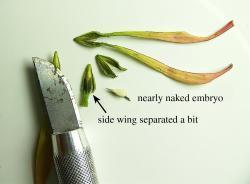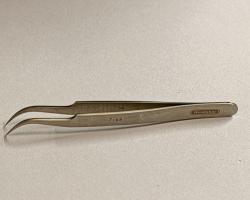ZenMan said:Hello all,
It I were trying to germinate Honey Locust seeds, I think I would experiment with various ways of removing the seed coating entirely. I would try simple mechanical methods, using mechanical ways of gripping the seed and cutting or abrading the coating. I have it found it advantageous to save zinnia seeds while the seed coating is still green, and I can extract naked embryos using an Exacto knife. I can remove naked embryos and get, in effect, zero day germination.

I use some auxiliary equipment to help me extract embryos from green zinnia seeds.


I have also used that technique on Milkweed seeds and Devils Claw seeds, with a reasonable amount of success. In the future I plan to experiment with a rotary tool like a Dremel and various grinding attachments. Milkweed seeds remain a challenge for me. I think they must need some cold treatment to stimulate the embryo growth. 
ZM

Yes! This is a fantastic idea. I considered embryo extraction with some Acer griseum I am trying to grow, and they're a huge pain because they have a very long stratification period and can take up to 2 years to germinate. I have heard that you can stratify them for just 90 days, and then extract the embryo and get some rather good rates. However, these honey locust seeds would be perfect to experiment on and I would be very interested to try this out on this species. Thank you for the suggestion.
Have you tried soaking the seed coat normally and letting it degrade naturally, and then removing the seed coat then extracting the embryo? This is probably more applicable to a larger, hard-coated tree seed? It wouldn't be practical-same-day-germination, but it could be... well, I don't know either. Regular honey locust seeds take 4 weeks to germ minimum, I have no idea how much this process would speed that up.
I have the idea that it would be hard to do this, but I can't even comment on why because I just don't know enough. Does a mature tree seed have some attachment between its embryo/cotyledons and seed coat? Would it even be possible to separate the two, and if so what is the chance of doing that successfully? If I did degrade the seed coat with moisture, surely the inside would get some moisture too and that could fuse them? Or separate them? I really don't know.
Basically, I will give this a try. I'll document everything and do a write-up, I think it will be very interesting. Thank you for the suggestion!


